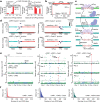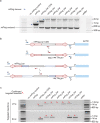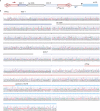Transposase-assisted target-site integration for efficient plant genome engineering
- PMID: 38926583
- PMCID: PMC11254759
- DOI: 10.1038/s41586-024-07613-8
Transposase-assisted target-site integration for efficient plant genome engineering
Abstract
The current technologies to place new DNA into specific locations in plant genomes are low frequency and error-prone, and this inefficiency hampers genome-editing approaches to develop improved crops1,2. Often considered to be genome 'parasites', transposable elements (TEs) evolved to insert their DNA seamlessly into genomes3-5. Eukaryotic TEs select their site of insertion based on preferences for chromatin contexts, which differ for each TE type6-9. Here we developed a genome engineering tool that controls the TE insertion site and cargo delivered, taking advantage of the natural ability of the TE to precisely excise and insert into the genome. Inspired by CRISPR-associated transposases that target transposition in a programmable manner in bacteria10-12, we fused the rice Pong transposase protein to the Cas9 or Cas12a programmable nucleases. We demonstrated sequence-specific targeted insertion (guided by the CRISPR gRNA) of enhancer elements, an open reading frame and a gene expression cassette into the genome of the model plant Arabidopsis. We then translated this system into soybean-a major global crop in need of targeted insertion technology. We have engineered a TE 'parasite' into a usable and accessible toolkit that enables the sequence-specific targeting of custom DNA into plant genomes.
© 2024. The Author(s).
Conflict of interest statement
Part of the funding that supported this research in the Slotkin laboratory was provided by Bayer Crop Science. X.Y. and L.A.G. work to improve crop gene editing for the for-profit company Bayer Crop Science. Patents have been filed with inventors R.K.S. and P.L. at the Donald Danforth Plant Science Center, and the technology is licensed to Bayer Crop Science for research purposes. The following patents have been filed, with R.K.S. and P.L. listed as inventors on both: (1) “Targeted insertion via transposition”; pending application numbers, US18/282,139, EP22772096.8, CA3,212,093 and AU2022237499A1; applicant, Donald Danforth Plant Science Center. (2) “Targeted insertion via transposition”; pending application number PCT/US2023/078837; applicant, Donald Danforth Plant Science Center.
Figures
















References
MeSH terms
Substances
LinkOut - more resources
Full Text Sources
Other Literature Sources
Molecular Biology Databases

